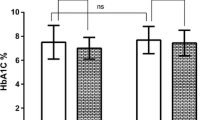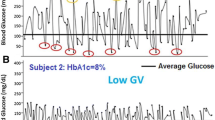Abstract
Aims
The aim of our study was to assess, with Continuous Glucose Monitoring (CGM), exhaustive information on the glucose profile in people with diabetes starting chemotherapy. We also evaluated the adaptation of glucose-lowering drugs following analysis of CGM recordings.
Methods
Eighty-five people with diabetes starting chemotherapy were included in the ONCODIAB study. A CGM was worn for up to fourteen days in blinded mode before and after the diabetologist’s intervention to evaluate the impact of modifying the glucose-lowering drugs.
Results
Time spent in range was 67.2 ± 24.2%. Time below the target glucose range (TBR) (< 70 mg/dl) was 8.9% in all the study population. TBR was significantly higher in patients treated with at least one drug due to the risk of hypoglycemia compared to the others (11.5% vs. 4.4%, p = 0.009). Sixty-five patients had available sensor data for the two recordings. Forty-one patients (51.9%) saw a decrease in their antidiabetic treatment after the diabetologist’s intervention guided by the first CGM recording. We observed a significant reduction in the time spent below the target glucose range (70–55 mg/dl) between the two CGM recordings (10.3 ± 14.6% vs. 6.3 ± 9.4%, p = 0.016 and 3.8 ± 8.4% vs. 1.2 ± 2.9%, p = 0.012, respectively).
Conclusions
CGM use in blinded mode could be an interesting tool to reduce the risk of hypoglycemia in people with diabetes starting chemotherapy. Our findings fully support the recommendation that assessing hypoglycemia risk should be mandatory in patients with diabetes before starting chemotherapy.
Similar content being viewed by others
References
Joharatnam-Hogan N, Chambers P, Dhatariya K, Board R; the Joint British Diabetes Society for Inpatient Care (JBDS), UK Chemotherapy Board (UKCB) (2022) A guideline for the outpatient management of glycaemic control in people with cancer. Diabet Med 39:e14636
Jing L, Ni-ya N, Qun-xian R et al (2017) Pretreatment glycemic control status is an independent prognostic factor for cervical cancer patients receiving neoadjuvant chemotherapy for locally advanced disease. BMC Cancer 17:517
Nik-Ahd F, Howard LE, Eisenberg AT et al (2019) Poorly controlled diabetes increases the risk of metastases and castration-resistant prostate cancer in men undergoing radical prostatectomy: results from the search database. Cancer 125:2861–2867
Shariff AI, Syed S, Shelby RA et al (2019) Novel cancer therapies and their association with diabetes. J Mol Endocrinol 62:R187–R199
American Diabetes Association (2020) Diabetes technology: standards of medical care in diabetes-2020. Diabetes Care 43:S77-88
Battelino T, Danne T, Bergenstal RM et al (2019) Clinical targets for continuous glucose monitoring data interpretation: recommendations from the international consensus on time in range. Diabetes Care 42:1593–1603
Wada E, Onoue T, Kobayashi T et al (2020) Flash glucose monitoring helps achieve better glycemic control than conventional self-monitoring of blood glucose in non-insulin-treated type 2 diabetes: a randomized controlled trial. BMJ Open Diab Res Care 8:e001115
Haak T, Hanaire H, Ajjan R et al (2017) Flash glucose-sensing technology as a replacement for blood glucose monitoring for the management of insulin-treated type 2 diabetes: a multicenter, open-label randomized controlled trial. Diabetes Ther 8:55–73
Ashley L, Kassim S, Kellar I et al (2022) Identifying ways to improve diabetes management during cancer treatments (INDICATE): protocol for a qualitative interview study with patients and clinicians. BMJ Open 12:e060402
Hershey DS, Given B, Given C, et al (2014) Predictors of diabetes self-management in older adults receiving chemotherapy. Cancer Nurs 37:97–105
Pinheiro LC, Soroka O, Kern LM, et al (2020) Diabetes care management patterns before and after a cancer diagnosis: a SEER-medicare matched cohort study. Cancer 126:1727–1735
Zanders MM, van Herk-Sukel MP, Herings RM et al (2015) Impact of cancer on adherence to glucose-lowering drug treatment in individuals with diabetes. Diabetologia 58:951–960
Lee AK, Warren B, Lee CJ et al (2018) The association of severe hypoglycemia with incident cardiovascular events and mortality in adults with type 2 diabetes. Diabetes Care 41(1):104–111
Worndl E, Fung K, Fischer HD et al (2018) Preventable diabetic complications after a cancer diagnosis in patients with diabetes: a population-based cohort study. JNCI Cancer Spectr 2:pky008
Vigersky R, Shrivastav M (2017) Role of continuous glucose monitoring for type 2 in diabetes management and research. J Diabetes Complicat 31(1):280–287
Galindo RJ (2020) Comparison of the freestyle libre pro flash continuous glucose monitoring (CGM) system and point-of-care capillary glucose testing in hospitalized patients with type 2 diabetes treated with basal-bolus insulin regimen. Diabetes Care 43:2730–2735
Ragni A, Retta F, Arvat E et al (2021) Diabetes in cancer patients: risks, goals and management. Front Horm Res 54:103–114
Lavdaniti M, Michalopoulou S, Owens DA et al (2021) The impact of comorbid diabetes type 2 on quality of life in cancer patients undergoing chemotherapy. Endocr Metab Immune Disord Drug Targets 21:1017–1024
Funding
The authors did not receive support from any organization for the submitted work. No funding was received to assist with the preparation of this manuscript. No funding was received for conducting this study. No funds, grants, or other support was received.
Author information
Authors and Affiliations
Corresponding author
Ethics declarations
Conflict of interest
We have no conflict of interest for this study.
Additional information
Managed by Giovanni Sartore.
Publisher's Note
Springer Nature remains neutral with regard to jurisdictional claims in published maps and institutional affiliations.
Rights and permissions
Springer Nature or its licensor (e.g. a society or other partner) holds exclusive rights to this article under a publishing agreement with the author(s) or other rightsholder(s); author self-archiving of the accepted manuscript version of this article is solely governed by the terms of such publishing agreement and applicable law.
About this article
Cite this article
Legris, P., Bouillet, B., Pâris, J. et al. Glycemic control in people with diabetes treated with cancer chemotherapy: contribution of continuous glucose monitoring. Acta Diabetol 60, 545–552 (2023). https://doi.org/10.1007/s00592-023-02032-z
Received:
Accepted:
Published:
Issue Date:
DOI: https://doi.org/10.1007/s00592-023-02032-z




